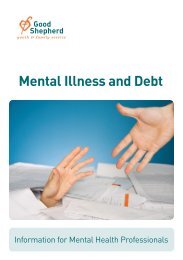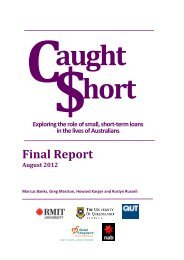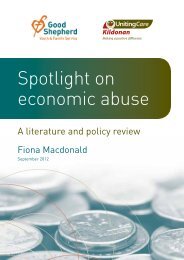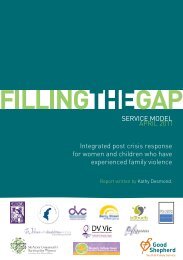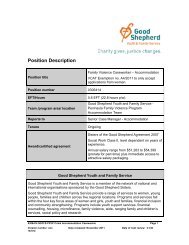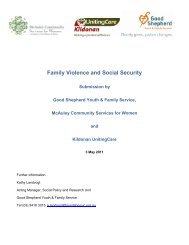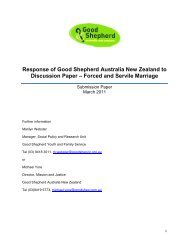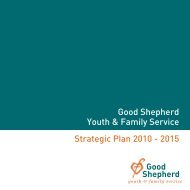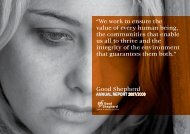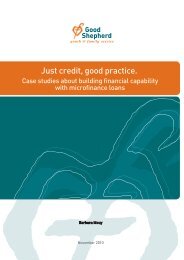Spotlight on economic abuse - Good Shepherd Youth & Family ...
Spotlight on economic abuse - Good Shepherd Youth & Family ...
Spotlight on economic abuse - Good Shepherd Youth & Family ...
You also want an ePaper? Increase the reach of your titles
YUMPU automatically turns print PDFs into web optimized ePapers that Google loves.
Ec<strong>on</strong>omic <strong>abuse</strong> and elder <strong>abuse</strong><br />
Ec<strong>on</strong>omic <strong>abuse</strong> of older people has also been identified as a comm<strong>on</strong> form of ‘elder <strong>abuse</strong>’,<br />
which is a c<strong>on</strong>cept that is different from, but has a significant overlap with, domestic and<br />
family violence. Elder <strong>abuse</strong> may be a form of domestic or family violence or it may occur<br />
outside intimate pers<strong>on</strong>al and family relati<strong>on</strong>ships. The term refers to the harm or neglect of<br />
an older pers<strong>on</strong> by a pers<strong>on</strong> with whom the older pers<strong>on</strong> has a relati<strong>on</strong>ship of a kind that<br />
implies trust and/or dependence (ABS 2006; Elder Abuse Preventi<strong>on</strong> Unit, viewed 7 July<br />
2012 at ). Thus, elder <strong>abuse</strong> perpetrated by a<br />
partner, family member or by an unpaid carer in an informal relati<strong>on</strong>ship is a form of<br />
domestic or family violence while the c<strong>on</strong>cept also includes <strong>abuse</strong> in a much wider range of<br />
relati<strong>on</strong>ships, including with paid carers and in paid care settings (Office of the Public<br />
Advocate 2010, Queensland Law Society 2010). Outside Australia the term has also been<br />
used to refer to single incidents such as decepti<strong>on</strong> or c<strong>on</strong>trolling behaviour perpetrated by<br />
strangers; for example salespeople (Straka & M<strong>on</strong>tminy 2006). However, in Australia <strong>abuse</strong><br />
or fraud perpetrated by strangers is not usually included in definiti<strong>on</strong>s of elder <strong>abuse</strong>.<br />
In Australia, the majority of <strong>abuse</strong>rs of older people (80-90 per cent) have been found to be<br />
close family members (Kurrle 2004, p.809). Several studies have found ec<strong>on</strong>omic <strong>abuse</strong> to<br />
be the most comm<strong>on</strong> form of reported or suspected elder <strong>abuse</strong> in family relati<strong>on</strong>ships, with<br />
the older pers<strong>on</strong>’s adult s<strong>on</strong> or daughter most likely to be the <strong>abuse</strong>r (Bagshaw, Wendt and<br />
Zannettino 2007). Seniors Rights Victoria (2012, p. 5) report that, am<strong>on</strong>g older people<br />
approaching their service for informati<strong>on</strong> and support relating to <strong>abuse</strong>, financial <strong>abuse</strong> is the<br />
most comm<strong>on</strong> form and it “most comm<strong>on</strong>ly manifests as financial loss arising from the<br />
disposal of an older pers<strong>on</strong>’s assets in exchange for their future care and accommodati<strong>on</strong>,<br />
often under pressure from another party”.<br />
The complex social and legal c<strong>on</strong>texts of elder <strong>abuse</strong> require additi<strong>on</strong>al c<strong>on</strong>siderati<strong>on</strong>s that<br />
are bey<strong>on</strong>d the scope of this paper. These include that <strong>abuse</strong> often occurs where an elderly<br />
pers<strong>on</strong> is vulnerable due to guardianship or power of attorney arrangements, which may be<br />
‘vehicles for financial elder <strong>abuse</strong>’ (Productivity Commissi<strong>on</strong> 2011, p. 454).<br />
Ec<strong>on</strong>omic <strong>abuse</strong>, labour exploitati<strong>on</strong>, trafficking and forced labour<br />
The boundaries between ec<strong>on</strong>omic <strong>abuse</strong> and other forms of violence and exploitati<strong>on</strong> can<br />
be blurred. While there is very limited evidence that other forms of <strong>abuse</strong> and exploitati<strong>on</strong><br />
are comm<strong>on</strong> in Australia they may be experienced by some women and there are groups<br />
who are vulnerable to such <strong>abuse</strong> and exploitati<strong>on</strong>. The most comm<strong>on</strong> form may be labour<br />
exploitati<strong>on</strong>, involving employment with pay and c<strong>on</strong>diti<strong>on</strong>s that are beneath minimum<br />
regulated standards (Nelms, Nichols<strong>on</strong> & Wheatley 2011). Women and younger men such<br />
as students and others <strong>on</strong> temporary visas may be particularly vulnerable to labour<br />
exploitati<strong>on</strong> (Burn et al. 2012). A situati<strong>on</strong> of forced labour exists where a pers<strong>on</strong> cannot<br />
leave the work because of threats or force (Burn et al. 2012) and some situati<strong>on</strong>s of forced<br />
labour may c<strong>on</strong>stitute slavery (Cullen & McSherry 2009). A separate problem is where<br />
women are trafficked to Australia for the purpose of placing them in exploitative or abusive<br />
situati<strong>on</strong>s such as into forced prostituti<strong>on</strong>.<br />
While the overlaps between ec<strong>on</strong>omic <strong>abuse</strong> and these other forms of <strong>abuse</strong> and<br />
exploitati<strong>on</strong> are recognised, this paper does not include an examinati<strong>on</strong> of this broader<br />
literature. Where labour exploitati<strong>on</strong> occurs within family and intimate partner relati<strong>on</strong>ships,<br />
for example where an abusive partner coerces a woman to work in a family enterprise<br />
without any benefit to the woman, this is within the definiti<strong>on</strong> of ec<strong>on</strong>omic <strong>abuse</strong> used in this<br />
paper. Elsewhere this type of situati<strong>on</strong> could be termed ‘servile marriage’. Servile marriage is<br />
11



